January 2005 LIP of the Month
Corresponds to event #2 in LIP record database.
The Ethiopian Large Igneous Province
Nicholas Arndt
LGCA, Univ. Grenoble, Grenoble, France
write Firstname.Lastname_AT_ujf-grenoble.fr
(substitute "Nicholas.Arndt@" for "Firstname.Lastname_AT_")
Martin A. Menzies
Dept. of Geology, Royal Holloway, University of London, Egham, UK
m.menzies@gl.rhul.ac.uk
Introduction
The Ethiopian flood basalts and associated felsic pyroclastic rocks erupted mainly around. 30 Ma ago during a relatively short, <5 Myr period (Figs. 1, 2) (McDougall et al., 1975; Berhe et al., 1987; Hoffman et al., 1997; Chernet et al., 1998; George et al., 1998; Rochette et al., 1998; Ukstins et al., 2002; Kieffer et al., 2004). Following this peak of activity, large shield volcanoes developed on the surface of the volcanic plateau and after this volcanism was confined to regions of rifting or local volcanic centres (Mohr, 1983; Mohr and Zanettin, 1988). More complex bimodal (i.e. mafic and felsic volcanism) magmatic systems were associated with such centres, in some cases involving caldera-forming eruptions. The rift that opened along the Red Sea and Gulf of Aden separating the Arabian and African continents, isolated part of the volcanic plateau in Yemen and Saudi Arabia (Chazot and Bertrand, 1993; Baker et al., 1996a; Menzies et al., 2001). Syn-rift volcanic activity continues to the present day on the uplifted rift shoulders of the Red Sea/Gulf of Aden and on ocean islands in the Red Sea and Gulf of Aden (Vidal et al., 1991; Schilling et al., 1992; Deniel et al., 1994).
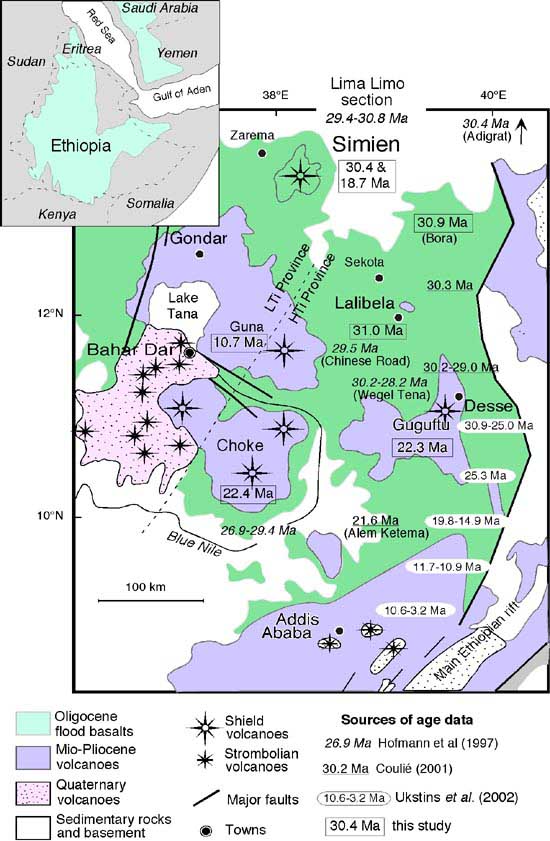
Figure 1: Map of the northern part of the Ethiopian plateau showing the extent of the flood volcanism and the location and ages of the major shield volcanoes (modified from Zanettin, 1992; Pik et al., 1999), with additional age data from Kieffer et al. (2004), Hofmann et al. (1997), Coulie et al. (2003) and Ukstins et al. (2002). The dashed line shows the boundary between the LT and HT provinces of Pik et al. (1999). The inset shows the location of the Ethiopian volcanic plateau (in grey) in the Horn of Africa.
The Ethiopian flood basalts are the youngest example of a major continental volcanic plateau. Because of their relatively young age and their eruption in a region where plate movements are slow, a complete record of volcanic and tectonic activity is preserved. The nature of volcanism has changed markedly during the Oligo-Miocene-Quaternary and includes : (a) high-flux, fissure-fed (Hawaiian), mafic flood volcanism (29-31 Ma) producing 1-2 km of mafic eruptives; (b), low flux, bimodal mafic-felsic volcanism from stratovolcanoes with associated caldera-forming (Ultra-Plinian) eruptions (26-29 Ma), producing ca. 1 km thickness of mafic-felsic eruptives. (c) minor mafic volcanism during a volcanic hiatus coincident with continental rifting and break-up (<19-26 Ma); (d) syn-rift bimodal mafic-felsic volcanism associated with rift valley formation and magmatic segmentation (Maguire et al., 2003) (<5 Ma).
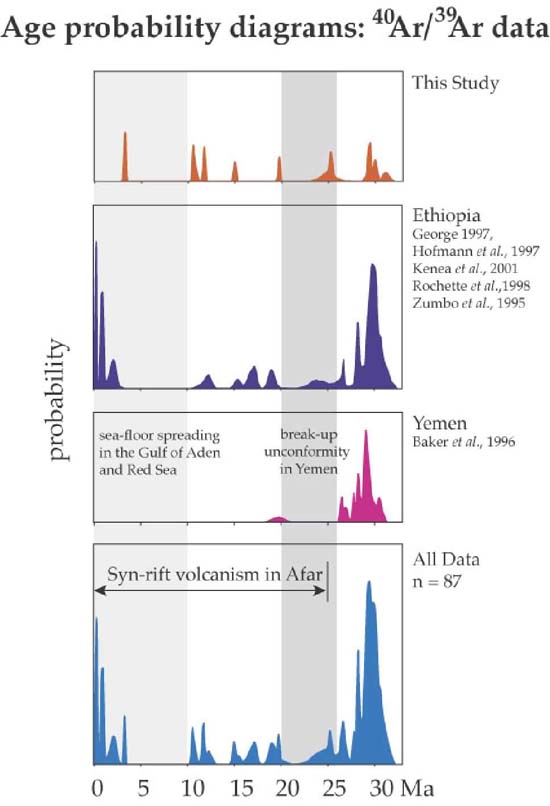
Figure 2: Geochronology of the Ethiopian LIP (see Ukstins-Peate et al., 2003 for details).
The region represents an ideal situation to study the dynamics of mantle sources involved in continental volcanism and the manner in which sources interacted with continental lithosphere (e.g., Mohr and Zanettin, 1988; Berhe et al 1987; Baker et al., 1996a; Hofmann et al., 1997; Pik et al., 1998, 1999; Baker et al., 2000, 2002; Ukstins et al., 2002; Ukstins-Peate et al., 2003; Kieffer et al., 2004).
Geological Background
The Ethiopian flood basalts (or traps) cover an area of about 600,000 km2 forming a layer of mafic and felsic volcanic rocks (Fig. 1). The thickness of this layer is highly variable but reaches 2 km in some regions. The total volume of extrusive and hypabyssal rocks has been estimated by Mohr (1983) and Mohr and Zanettin (1988) at about 350,000 km3.
The mineralogical and chemical composition of the flood basalts is relatively uniform. Most are aphyric to sparsely phyric, and contain phenocrysts of plagioclase and clinopyroxene with or without olivine. Most have tholeiitic to transitional compositions (Mohr, 1983; Mohr and Zanettin, 1988; Pik et al., 1998) (Figs. 3, 4). Inter-layered with the flood basalts are alkali picrites, and, particularly at upper stratigraphic levels, felsic lavas and pyroclastic rocks of rhyolitic, or less commonly, trachytic compositions (Ayalew et al., 2002; Ukstins et al., 2002; Ukstins-Peate et al., 2003).
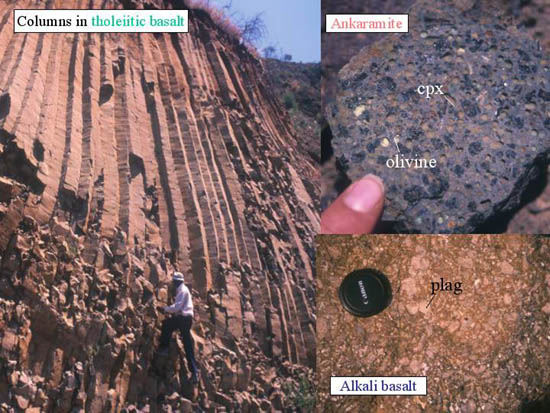
Figure 3: Photos of a columnar-jointed tholeiitic sheet flow, an olivine-cpx-phyric ankaramite, and a plagioclase-phyric trachybasalt.
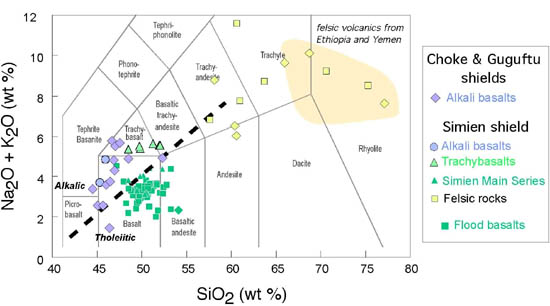
Figure 4: TAS diagram showing the compositions of mafic and felsic rocks from the Ethiopian volcanic plateau (symbols) and from Yemen (yellow field). Data from Kieffer et al. (2004); Baker et al. (1996a, 2000) and Ukstins-Peate (2003, 2005).
Pik et al. (1998, 1999) and Keiffer et al. (2004) divided the basaltic rocks into several types on the basis of trace-element and Ti concentrations. They recognized a suite of “low-Ti” basalts (LT) characterized by relatively flat rare-earth element (REE) patterns and low levels of Ti and incompatible trace elements (Figs. 5, 6). These rocks are largely restricted to the northwestern part of the province, as shown in Fig. 1. Alkali basalts with higher concentrations of incompatible elements and more fractionated REE patterns — the so-called “high-Ti” basalts (HT1 and HT2) — are found to the south and east. The HT2 basalts are slightly more magnesian than the HT1 basalts and commonly are rich in olivine ± clinopyroxene phenocrysts. They have higher concentrations of incompatible elements and show extreme fractionation of the REE. Although most of the volcanic plateau erupted in a short period between 31 and 30 Ma (Hofmann et al., 1997), the upper parts of the flood volcanic pile have ages to around 25 Ma, suggesting a relatively protracted period of flood volcanism (Ukstins et al., 2002).
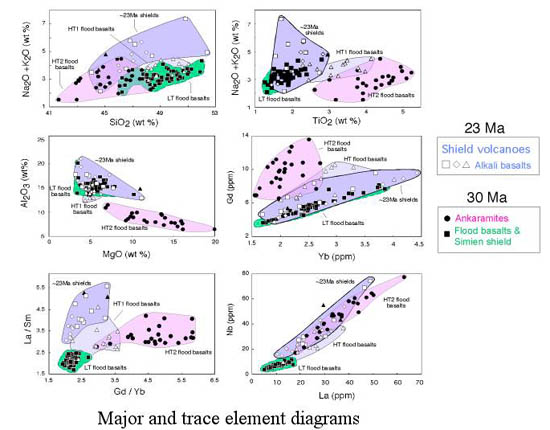
Figure 5: Major and trace element characteristics of volcanic rocks from flood volcanics and shield volcanoes of the northern part of the Ethiopian volcanic plateau. Data from Kieffer et al. (2004), Pik et al. (1999), and unpublished analyses.
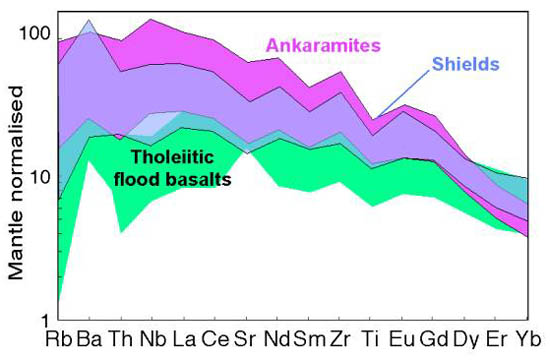
Figure 6: Trace-element concentrations, normalized to primitive mantle of Hofmann (1988), of samples from the Simien volcano and underlying flood basalts.
Shield volcanoes (Figs. 7, 8), a conspicuous feature of the Ethiopian plateau, are composed predominantly of alkaline basalts, with minor felsic lavas and pyroclastic rocks near their summits (Mohr and Zanettin, 1988; Keiffer et al., 2004). The basal diameters of the shields range from 50 to 100 km and the highest point in Ethiopia, the 4533 m high peak of Ras Dashan, is the present summit of the eroded Simien shield. The ages of the shield volcanoes range from 30-31 Ma for the Simien shield in the north of the province, essentially the same as that of underlying flood basalts, to less than 3 Ma for shields in the south of the province (Zanettin, 1992; Ukstins et al., 2002). The tholeiitic Simien shield surmounts tholeiitic flood basalts and the two probably form parts of the same magmatic system. The 23 Ma Choke and Guguftu shields in the central northern part of the plateau are alkaline and they overlie a thin sequence of 23 Ma alkaline flood basalts. Finally, still younger silica-undersaturated lavas erupted from 11 Ma (Guna) to recent times, in shields or small cones, in various parts of province.
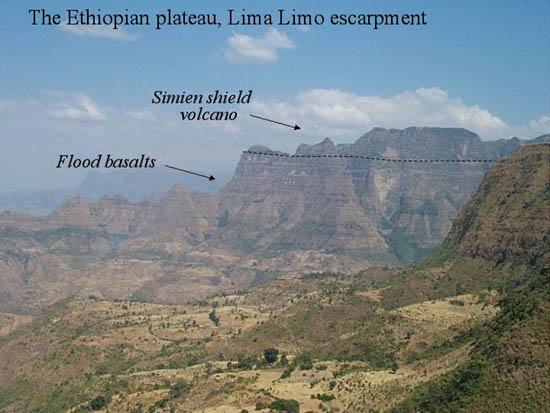
Figure 7: Photo of the Ethiopian flood basalts overlain by the lower flows of the Simien shield volcano.
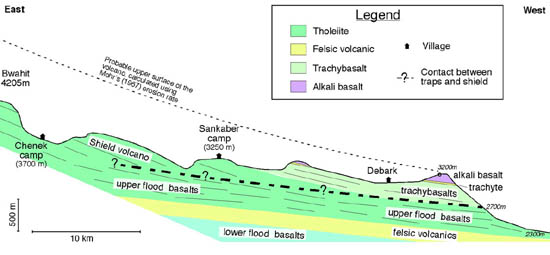
Figure 8: Diagrammatic section through the Simien shield volcano and underlying flood basalts. (see Kieffer et al., 2004 for details).
Thick sheets of felsic pyroclastic rocks, dacites and rhyolites, make up a significant proportion, up to 30%, of the upper parts of the volcanic plateau. The geology, geochemistry and petrogenesis of these felsic rocks has been described recently by Ayalew et al. (2002), and Ukstins-Peate et al. (2003, 2005). Volcano-, chemo-, and chrono-stratigraphic correlations between Yemen and Ethiopia indicates that the source of these felsic rocks may relate to volcanic centres (e.g. calderas) now located in Yemen (Ukstins-Peate et al., 2005) (Fig. 9). Pyroclastic fall deposits from Plinian to UtraPlinian eruptions during the Oligo-Miocene in Ethiopia-Yemen are found 3000 km from their source (Touchard et al., 2003; Ukstins-Peate et al., 2003).
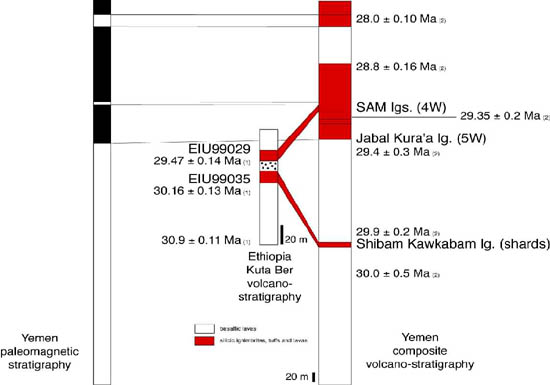
Figure 9: Felsic volcanic rocks from Ethiopia and Yemen. Two felsic eruptive units in Ethiopia (ca.30 Ma) match ignimbrites in Yemen and distal co-ignimbrite ash deposits in the Indian Ocean (see Ukstins et al., 2002, Ukstins-Peate, 2003 for details).
The post-trap, syn-rift volcanism in the regions of active rifting around Addis Ababa and Djibouti and in the Arabian Peninsula has been the subject of numerous publications (e.g. Justin Visentin et al., 1974; Zanettin et al., 1978; Barrat et al., 1990; Deniel et al., 1994; Baker et al., 1998, 2000, 2002). With the exception of the stratoid unit, a small sequence of basaltic sheet flows, the volcanic activity is largely confined to small bimodal, mafic-felsic stratovolcanoes.
Is the Ethiopian Plateau a Typical Flood Basalt Province?
Type examples of continental flood basalts, such as those of the Deccan and Karoo provinces, are described as thick, monotonous sequences of thick, continuous, near-horizontal flows of tholeiitic basalt. In contrast, the Ethiopian province is made up of a series of flood basalts overlain by large and conspicuous shield volcanoes. Are the differences real, or are they a consequence of differing extents of erosion and degrees of preservation, compounded by incomplete sampling of these vast volcanic structures?
Ethiopia is the youngest major flood basalt province. It is one of the least deformed, and probably the only one in which the uppermost volcanic units are well preserved. Although the upper levels of other, older provinces such as the Deccan and Karoo are strongly eroded, there is solid evidence that flat-lying tholeiitic basalt flows erupted from start to finish of volcanic episode, and that shield volcanoes never formed. In these examples, the main phase of flood volcanism produced large horizontal flows that can be followed for many kilometres, and are difficult to relate with any specific volcanic centre. No direct link between flood and shield volcanism can be established. The situation is different in Ethiopia where the upper part of the volcanic sequence is dominated by the large shield volcanoes. Keiffer et al. (2004) present geological and geochemical data that indicates that in many cases the shield volcanism was comagmatic with the flood volcanism that formed the main volcanic plateau.
Distinctive petrological features of the Ethiopian plateau are the transitional tholeiitic to alkaline magmatic character of the mafic lavas, in contrast with the tholeiitic character of most continental flood basalts, and the high proportion of felsic pyroclastic rocks.
Origin of the lavas
The concentrations of incompatible trace elements vary enormously in lavas from the Ethiopian plateau. At one extreme, the LT tholeiites have flat normalized trace element patterns, with mantle normalized Nb contents (NbN) around 10 times primitive mantle; at the other, the HT2 type alkali picrites have steeply dipping patterns and NbN contents more than 100 times primitive mantle. The various lava types have similar Nd and Sr isotopic compositions but very different Pb isotopic compositions (Fig. 10). Some have a weak “HIMU” (high 206Pb/204Pb and low 87Sr/86Sr) character. Lavas in a large region surrounding the volcanically active Afar region have high 3He/4He ratios (Marty et al., 1996).
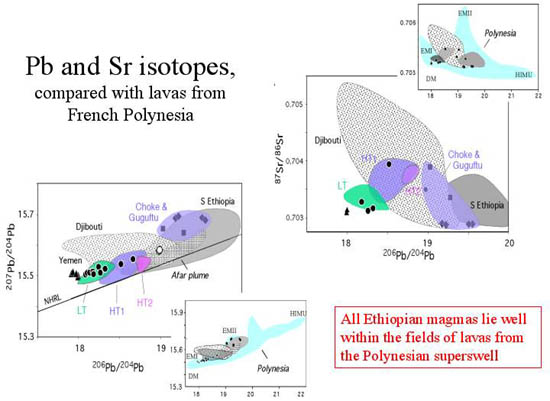
Figure 10: Pb and Sr isotope compositions of Ethiopian volcanic rocks compared with compositions from other parts of the Horn of Africa (from Kieffer et al., 2004). The composition labelled “Afar plume” is defined by Baker et al. (1996b, 2002) using data of Vidal et al. (1991) and Schilling et al. (1992). The compositions of the rocks from French Polynesia, shown in the insets, are from the GEOROC data base http://georoc.mpch-mainz.gwdg.de/
In the literature, these variations are interpreted in terms of derivation of the parental magmas from various parts of the mantle; some from “the Afar plume”, or from various plumes, others from the lithospheric mantle, and still others from the asthenosphere. Keiffer et al. (2004) present another model. The major and trace element composition of the magmas are explained in terms of melting, to various degrees, of different components of a common, deep mantle source. Whether this source should be described as a plume is a matter of debate: it was large and hotter than ambient mantle; it was heterogeneous, both compositionally and thermally; and it was capable of producing large volumes of magma over a protracted period. Comparison can be made with volcanism in Polynesia, where magmas of diverse chemical and isotopic compositions are derived from a heterogeneous mantle source within the Pacific “superswell”. The high MgO contents, the high trace element contents and the steeply dipping HREE patterns of the HT2 picrites reflect low-degree melting of a peridotite source at depths well below the base of the lithosphere.
Baker et al. (2000) showed that zoned phenocrysts in highly magnesian mafic volcanic rocks (e.g., picrites/ankaramites) display marked variations in Sr-Nd-O isotope composition. Such highly magnesian rocks can become highly contaminated with crustal rocks. However once the effects of minor crustal contamination are stripped from the compositions of the LT lavas, the composition of the parental magma is seen as well to be picritic and consistent with derivation from a sub-lithosphere source. Although xenoliths from the lithospheric mantle below Ethiopia and the Arabian Peninsular have a weak HIMU character like that of some of the lavas, this feature is thought to have been transferred to the lithosphere from the deep mantle source of the lavas: it does not indicate that the lithosphere was the source of these magmas (Baker et al., 1998, 2002).
The felsic volcanic rocks in Ethiopia-Yemen, occurring as pyroclastic flow and fall deposits, are highly fractionated with rhyolitic-trachytic-dacitic compositions (Fig. 4). Some of the most evolved felsic rocks occur as co-ignimbrite fall deposits and can be matched with proximal ignimbrites in Ethiopia and Yemen (Ukstins-Peate et al., 2003, 2005). A silica gap is apparent between the mafic (basaltic) and felsic (rhyolitic) volcanic units indicative of a complex petrogenetic process, as yet not fully understood. The presence of proximal and distal pyroclastic flow and fall deposits has important implications for magmatic systems within flood basalt provinces. Clearly major magmatic centres (e.g. stratovolcanoes) had developed by 29 Ma and the collapse of these volcanic structures to produce calderas, fuelled Plinian to Ultraplinian eruptions.
Relationship between magmatism and tectonics
Systematic dating of volcanic and tectonic activity provides strong constraints on how the mantle source of the Ethiopian plateau interacted with the lithosphere, and how this interaction was linked to rifting (Davison and Rex 1980). Menzies et al. (1992, 1997, 2001) have used geological observations, detailed geochronology and fission track studies to establish the timing of magmatism and rifting. Chazot et al. (1998) demonstrated that the spatial distribution of pre-rift alkaline and tholeiitic volcanism from Ethiopia to Jordan mimicked the orientation of the “proto-Red Sea rift”. This may indicate an early (é30 Ma) control on rift orientation and formation. In Ethiopia, magmatism (ca. 31 Ma) predated break-up extension by è5 Myr (Baker et al., 1996a; Hoffman et al., 1997; Menzies et al., 1997, 2001; Ukstins et al., 2002). A significant volcanic hiatus occurred in Ethiopia (ca. 22-26 Ma) and coincided with a period of erosion and extension (19-26 Ma) on the conjugate margin in Yemen. In the main part of the Ethiopian (and Yemeni) plateau (the SW portion is older, George and Rogers, 2002) metre-scale uplift seems to have preceded the onset of flood volcanism, whereas kilometer-scale uplift was synchronous with main phase of flood volcanism. Studies of the absolute and relative timing of rift processes in Ethiopia and Yemen indicates that uplift and magmatism were followed by break-up extension and erosion. There is no unequivocal evidence for either widespread extension or kilometer-scale uplift significantly prior to magmatism. As proposed by Courtillot et al. (1999) the plume heated and weakened the lithosphere, processes that eventually led to localized rifting. Since the break-up of Africa and Arabia, active magmatism and tectonics has been centred in the northern Ethiopian rift valley. In northern Ethiopia, Maquire et al. (2003) used geophysical data to illustrate the switch from border fault-dominated rifting to magmatic segmentation, an important part of the continent-ocean transition. Similarly Klausen and Larsen (2002) demonstrated a switch from tectonic rifting to magmatic segmentation on the Greenland margin (associated with the North Atlantic Igneous Province).
Subduction to the northeast provided drag that led eventually to successful rifting, first westward along the Gulf of Aden, then southward along the Red Sea: the rift propagated towards the weakened lithosphere below the centre of the volcanic province.
References
Ayalew D, Barbey P, Marty B, Reisberg L, Yirgu G, and Pik R (2002). Source, genesis and timing of giant ignimbrite deposits associated with Ethiopian continental flood basalts. Geochimica et Cosmochimica Acta, 66, 1429-1448.
Baker, J., Chazot, G., Menzies, M. A. and Thirlwall, M. (2002). Lithospheric mantle beneath Arabia: a Pan-African protolith modified by the Afar and older plumes, rather than a source for continental flood volcanism. In: M. A. Menzies, S. L. Klemperer, C. J. Ebinger and J. Baker (Editors) Volcanic Rifted Margins, Volume Special Paper 362, pp. 65-80. Geological Society of America.
Baker, J., Chazot, G., Menzies, M. A. and Thirlwall, M. F. (1998). Metasomatism of the shallow mantle beneath Yemen by the Afar plume — implications for mantle plumes, flood volcanism and intraplate volcanism. Geology 26, 431-434.
Baker, J., MacPherson, C. G., Menzies, M. A., Thirlwall, M. F., Al-Kadasi, M. and Mattey, D. P. (2000). Resolving crustal and mantle contributions to continental flood volcanism, Yemen; constraints from mineral oxygen isotope data. Journal of Petrology 41, 1805-1820.
Baker, J., Snee, L. and Menzies, M. A. (1996a). A brief Oligocene period of flood volcanism in Yemen: implications for the duration and rate of continental flood basalt volcanism at the Afro-Arabian triple junction. Earth and Planetary Science Letters 138, 39-55.
Baker, J., Thirlwall, M. and Menzies, M. A. (1996b). Sr-Nd-Pb isotopic and trace element evidence for crustal contamination of plume-derived flood basalts: Oligocene flood volcanism in western Yemen. Geochimica Cosmochimica Acta 60, 2559-2581.
Barrat, J. A., Jahn, B. M., Joron, J. L., Auvray, B. and Hamdi, H. (1990). Mantle heterogeneity in NE Africa: evidence from Nd isotopic composition and hygromagmaphile element geochemistry of basaltic rocks from the Gulf of Tadjoura and southern Red Sea regions Earth and Planetary Science Letters 101, 233-247.
Berhe, S.M., Desta, B., Nicoletti, M., and Teferra, M. (1987). Geology, geochronology and geodynamic implications of the Cenozoic magmatic province of W and SE Ethiopia. J. Geological Society of London 144, 213-266.
Chazot, G. and Bertrand, H. (1993). Mantle sources and magma-continental crust interactions during early Red Sea-Aden rifting in Southern Yemen: elemental and Sr, Nd, Pb isotope evidence. Journal of Geophysical Research 98, 1818-1835.
Chazot, G., Menzies, M.A. and Baker, J.A.(1998). Pre- syn- and post-rift volcanism on the south-western margin of the Arabian plate. In: Sedimentation and Tectonics in Rift Basins Red Sea - Gulf of Aden. (Purser, B.H., Bosence, D.W.J., eds.) Chapman & Hall, London, 50-55.
Chernet, T., Hart, W.K., Aronson, J.L., and Walter, R.C. (1998). New age constraints on the timing of volcanism and tectonism in the northern main Ethiopian rift-southern Afar transition zone (Ethiopia). J. Volcanology and Geothermal Research, 80, 267-280.
Coulie, E., Quideleur, X., Gillot, P.-Y., Courtillot, V., Lefevre, J.-C. and Chiesa, S. (2003). Comparative K-Ar and Ar/Ar dating of Ethiopian and Yemenite Oligocene volcanism: implications for timing and duration of the Ethiopian traps. Earth and Planetary Science Letters 206, 477-492.
Courtillot, V., Jaupart, C., Manighetti, I., Tapponier, P., and Besse, J., (1999). On causal links between flood basalts and continental breakup: Earth Planet. Sci. Lett. 166, 177-195.
Davison, A., and Rex, D.C. (1980). Age of volcanism and rifting in southwestern Ethiopia. Nature 283, 657-658.
Deniel, C., Vidal, P., Coulon, C., Vellutini, P. J. and Piguet, P. (1994). Temporal evolution of mantle sources through continental rifting: the volcanism of Djibouti (Afar). Journal of Geophysical Research 99, 2853-2869.
George, R. M. and Rogers, N. W. (2002). Plume dynamics beneath the African plate inferred from the geochemistry of the Teriary basalts from southern Ethiopia. Contributions to Mineralogy and Petrology 144, 286-304.
George, R., Rogers, N., and Kelley, S. (1998). Earliest magmatism in Ethiopia : evidence for two mantle plumes in one flood basalt province. Geology 26, 923-926.
Hofmann, A.W. (1988). Chemical differentiation of the Earth: the relationship between mantle, continental crust, and oceanic crust. Earth and Planetary Science Letters 90, 297-314.
Hofmann, C., Courtillot, V., Feraud, G., Rochette, P., Yirgu, G., Ketefo, E. and Pik, R. (1997). Timing of the Ethiopian flood basalt event and implications for plume birth and global change. Nature 389, 338-341.
Justin Visentin, E., Nicoletti, M., Tolomeo, L. and Zanettin, B. (1974). Miocene and Pliocene volcanic rocks of the Addis Ababa - Debra Berhan area (Ethiopia). Bulletin of Volcanology 38, 237-253.
Kieffer, B. and 11 co-authors (2004). The transition from Plateau to Shield volcanism in Ethiopia: a petrological and geochemical study of the Simien, Choke and Guguftu volcanoes and underlying flood basalts. Journal of Petrology, 45, 793-834.
Klausen, M.B. and Larsen, H.C. (2002). East Greenland coast-parallel dike swarm and its role in continental break-up. In: Volcanic Rifted Margins. Eds. Menzies, M.A., Klemperer, S.L., Ebinger, C.J. and Baker, J., Geological Society of America Special Paper, 362, 133-158.
Maguire, P. and 15 co-authors (2003). Geophysical project in Ethiopia studies continental breakup. Eos, Transaction of the American Geophysical Union 84, 337-340.
Marty, B., Pik, R., and Yirgu, G. (1996). Helium isotopic variations in Ethiopian plume lavas: Nature of magmatic sources and limit on lower mantle contribution: Earth and Planet Science Letters 144, 223-237.
McDougall, I., Morton, W.H., and Williams, M.A.J. (1975). Age and denudation rates of Trap Series basats in the Nile gorge., Ethiopia. Nature 254, 207-209.
Menzies, M., Baker, J., Bosence D., Dart, C., Davison, I., Hurford, A., Al-Kadasi, M., Mcklay, K., Nichols, G., Al-Subbary, A. and Yelland, A. (1992). The timing of magmatism, uplift and crustal extension: preliminary observations from Yemen. In: B. C. Storey, T. Alabaster & R. J. Pankhurst (Editors) Magmatism and the cause of continental breakup, Geological Society Special Publication, pp. 293-304.
Menzies, M., Baker, J. and Chazot, G. (2001). Cenozoic plume evolution and flood basalts in Yemen: a key to understanding older examples. In: Ernst, R.E. and Buchan, K.L. (eds.) Mantle plumes: their identification through time, The Geological Society of America, 352, pp. 23-36.
Menzies, M.A., Gallagher, K., Yelland, A., and Hurford, A.J. (1997). Volcanic and nonvolcanic rifted margins of the Red Sea and Gulf of Aden: Crustal cooling and margin evolution in Yemen. Geochimica Cosmochimica Acta 61, 2511-2527.
Mohr, P. (1983). Ethiopian flood Basalt province. Nature 303, 577-584.
Mohr, P. and Zanettin, B. (1988). The Ethiopian flood basalt province. Continental flood basalts. Kluwer Academic Publications, Dordrecht, 63-110.
Pik, R., Deniel, C., Coulon, C., Yirgu, G., Hoffmann, C. and Ayalew, D. (1998). The northwestern Ethiopian Plateau flood basalts: Classification and spatial distribution of magma types. Journal of Volcanology and Geothermal Research 81, 91-111.
Pik, R., Deniel, C., Coulon, C., Yirgu, G. and Marty, B. (1999). Isotopic and trace element signatures of Ethiopian basalts: Evidence for plume-lithospheric interactions. Geochimica Cosmochimica Acta 63, 2263-2279.
Rochette, P., Tamrat, E., Feraud, G., Pik, R., Courtillot, V., Ketefo, E., Coulon, C., Hofmann, C., Vandamme, D., and Yirgu, G. (1998). Magnetostratigraphy and timing of Oligocene Ethiopian traps. Earth and Planetary Science Letters 164, 497-510.
Schilling, J.-G., Kingsley, R. H., Hanan, B. B. and McCully, B. L. (1992). Nd-Sr-Pb isotopic variations along the Gulf of Aden: evidence for Afar mantle plume-continental lithosphere interaction. Journal of Geophysical Research 97, 10,927-10,966.
Touchard, Y., Rochette, P., Aubry, M.P., and Michard, A. (2003). High-resolution magnetostratigraphy and biostratigraphic study of Ethiopian traps-related products in Oligocene sediments from the Indian Ocean. Earth and Planetary Science Letters 206, 293-508.
Ukstins, I.A, Renne, P.R., Wolfenden, E., Baker, J., Ayalew, D. and Menzies, M. (2002). Matching conjugate volcanic rifted margins: 40Ar/39Ar chrono-stratigraphy of pre- and syn-rift bimodal flood volcanism in Ethiopia and Yemen. Earth and Planetary Science Letters 198, 289-306.
Ukstins-Peate, I., Baker, J.A., Kent, A.J.R., Al-Kadasi, M., Al-Subbary, A., Ayalew, D. and Menzies, M. (2003). Correlation of Indian Ocean tephra to individual Oligocene silicic eruptions from Afro-Arabian flood volcanism. Earth and Planetary Science Letters 211, 311-327.
Ukstins-Peate, I., Baker, J.A., Al-Kadasi, M., Al-Subbary, A., Knight, K.B., Riisager, P., Thirlwall, M.F., Peate, D., Renne, P. and Menzies, M. (2005). Volcanic stratigraphy of large volume silicic pyroclastic eruptions during Oligocene Afro-Arabian flood volcanism in Yemen. Bulletin of Volcanology (in press).
Vidal, P., Deniel, C., Vellutini, P. J., Piguet, P., Coulon, C., Vincent, J. and Audin, J. (1991). Changes of mantle source in the course of a rift evolution. Geophysical Research Letters 18, 1913-1916.
Zanettin, B. (1992). Evolution of the Ethiopian Volcanic Province. Memorie Lincee Scienze Fisiche e Naturali 1, 155-181.
Zanettin, B., Justin Visentin, E. and Piccirillo, E. M. (1978). Volcanic succession, tectonics and magmatology in central Ethiopia. Atti Memorie dell'Accademia Patavina di Scienze Lettere ed Arti 90, 5-19.
